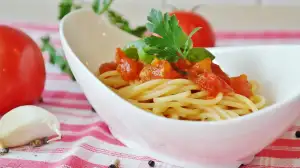Celebrate North African Cuisine with Flavorful Couscous Creations

Couscous, a staple in North African cuisine, is a versatile and nutritious dish made from tiny granules of durum wheat or semolina. This light and fluffy grain has gained popularity worldwide for its delicate texture and ability to absorb flavors from various ingredients. Couscous serves as a blank canvas for a myriad of spices, vegetables, meats, and sauces, making it a beloved choice for creating diverse and flavorful dishes. Whether served as a side dish or the main course, couscous offers a delightful culinary experience that transports diners to the vibrant streets of North Africa.
History and Origins of Couscous
Couscous, a staple in North African cuisine, has a rich history dating back to the Berber tribes of North Africa. Believed to have originated in present-day Algeria, couscous spread throughout the region and became a culinary tradition in countries like Morocco, Tunisia, and Libya. Its name is derived from the Berber word "k'seksu," which means well-rounded or well-formed. Over time, couscous evolved from a simple grain dish to a symbol of hospitality and celebration in North African culture. Its versatility and ability to adapt to various flavors and ingredients have made it a beloved dish worldwide.
Ingredients Used in Making Couscous
Couscous, a staple in North African cuisine, is made from semolina wheat. The main ingredient, semolina, is a coarse flour that gives couscous its distinctive texture. Water is added to the semolina to create a dough-like mixture which is then rolled into tiny granules. These granules are steamed until fluffy and separated into light, fluffy grains ready for consumption. Some variations may include additional ingredients like olive oil or salt for flavor enhancement, but the basic components remain semolina and water.
Traditional Preparation Methods of Couscous
Traditional Preparation Methods of Couscous involve steaming the tiny grains of semolina wheat. The process begins by moistening the couscous with water and rubbing it between the hands to create small granules. The moistened couscous is then placed in a special steamer called a couscoussier, which has two levels - the bottom for simmering a flavorful stew and the top for steaming the couscous. The steam from the stew below cooks the couscous, infusing it with rich flavors while keeping it light and fluffy. This method allows for even cooking and ensures that each grain remains separate and tender, ready to soak up any accompanying sauce or toppings.
Variations of Couscous Across North Africa
Variations of couscous across North Africa showcase the diverse culinary traditions of the region. In Morocco, couscous is often served with a savory stew called tagine, featuring meats like lamb or chicken with vegetables and aromatic spices. Tunisian couscous, on the other hand, may include seafood such as shrimp or fish in its preparation. Algerian couscous tends to be spicier, incorporating harissa paste for a fiery kick. Each country's unique blend of flavors and ingredients adds depth and richness to this beloved dish.
Health Benefits of Couscous
Couscous, a staple in North African cuisine, offers numerous health benefits. It is a good source of complex carbohydrates, providing sustained energy levels. Additionally, couscous is low in fat and contains fiber, aiding digestion and promoting a healthy gut. It also contains essential minerals such as selenium and phosphorus, important for overall well-being. Couscous is a versatile ingredient that can be incorporated into a balanced diet to support a healthy lifestyle.
Serving Suggestions and Pairings for Couscous
When it comes to serving couscous, there are various delicious options to consider. Couscous pairs well with a variety of dishes, making it a versatile addition to any meal. One classic way to enjoy couscous is by serving it alongside grilled vegetables such as zucchini, bell peppers, and eggplant. The light and fluffy texture of couscous complements the smoky flavors of grilled veggies perfectly.
For a heartier meal, couscous can also be paired with protein-rich options like grilled chicken, lamb, or fish. The nutty flavor of couscous enhances the taste of these meats while providing a satisfying base for the dish. Additionally, adding fresh herbs like mint or parsley can elevate the flavors of the dish and add a refreshing touch.
If you're looking for a vegetarian option, couscous salad is a popular choice. Mix cooked couscous with diced tomatoes, cucumbers, red onions, feta cheese, and olives for a Mediterranean-inspired salad that is both flavorful and nutritious. Drizzle with olive oil and lemon juice for a light dressing that ties all the ingredients together.
Whether served hot or cold, as a side dish or main course, couscous offers endless possibilities for creative pairings that cater to various tastes and dietary preferences. Its versatility makes it an ideal choice for both casual meals and special occasions alike.
Popular Couscous Recipes to Try at Home
1. Moroccan Vegetable Couscous: A flavorful dish made with a mix of seasonal vegetables like carrots, zucchini, and bell peppers cooked in a savory broth and served over fluffy couscous.
2. Tunisian Spicy Fish Couscous: A spicy and aromatic dish featuring tender fish fillets simmered in a tomato-based sauce with harissa, cumin, and paprika, served atop steamed couscous.
3. Algerian Lamb and Chickpea Couscous: A hearty stew made with tender lamb chunks, chickpeas, onions, and tomatoes cooked in a blend of traditional spices like cinnamon and turmeric, served alongside fluffy couscous.
4. Libyan Lamb Kofta Couscous: Flavorful lamb kofta meatballs seasoned with herbs and spices, simmered in a rich tomato sauce with peas and potatoes, served over a bed of couscous.
These popular North African couscous recipes are not only delicious but also showcase the diverse flavors and culinary traditions of the region. Try them at home to experience the authentic taste of North African cuisine!
In conclusion, couscous is not just a dish; it's a symbol of North African culinary tradition and cultural heritage. Its versatility in flavor profiles and adaptability to various ingredients make it a beloved staple across the region and beyond. Whether enjoyed as a simple side dish or as a hearty main course, couscous offers a delicious and nutritious option for any meal. So, next time you're looking to savor the flavors of North Africa, consider diving into the world of couscous for a truly authentic culinary experience.
Published: 25. 04. 2024
Category: Food



